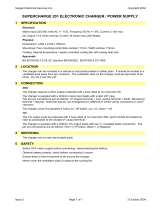
4A
Operation
Switch Modes
After configuring, mounting and connecting your Inverter/Charger, you
are able to operate it by switching between the following operating
modes as appropriate to your situation:
AUTO/REMOTE: Switch to this mode when you
need constant, uninterrupted AC power for connected
appliances and equipment. The Inverter/Charger will
continue to supply AC power to connected equipment
and to charge your connected batteries while utility-
or generator-supplied AC power is present. Since the
inverter is ON (but in Standby) in this mode, it will automatically
switch to your battery system to supply AC power to connected
equipment in the absence of a utility/generator source or in over/under
voltage situations. “AUTO/REMOTE” also enables an optional
remote control module (Tripp Lite model APSRM4, sold separately)
to function when connected to the unit.
CHARGE ONLY: Switch to this mode when you
are not using connected appliances and equipment in
order to conserve battery power by disabling the
inverter. The Inverter/Charger will continue to supply
AC power to connected equipment and charge con-
nected batteries while utility- or generator-supplied
AC power is present. However, since the inverter is OFF in this
mode, it WILL NOT supply AC power to connected equipment in the
absence of a utility/generator source or in over/under voltage situations.
OFF: Switch to this mode to shut down the
Inverter/Charger completely, preventing the inverter
from drawing power from the batteries, and preventing
utility AC from passing through to connected equipment
or charging the batteries. Use this switch to automatically
reset the unit if it shuts down due to overload or
overheating. First remove the excessive load or
allow the unit to sufficiently cool (applicable to your situation).
Switch to “OFF”, then back to “AUTO/REMOTE” or “CHARGE
ONLY” as desired. If unit fails to reset, remove more load or allow
unit to cool further and retry. Use an optional remote control mod-
ule (Tripp Lite model APSRM4, sold separately) to reset unit due to
overload only.
Indicator Lights
Your Inverter/Charger (as well as an optional Tripp Lite Remote
Control Module, sold separately) is equipped with a simple, intuitive,
user-friendly set of indicator lights. These easily-remembered “traffic
light” signals will allow you, shortly after first use, to tell at a glance
the charge condition of your batteries, as well as ascertain operating
details and fault conditions.
LINE Green Indicator: If the operating mode
switch is set to “AUTO/REMOTE,” this light will
ILLUMINATE CONTINUOUSLY when your con-
nected equipment is receiving continuous AC power
supplied from a utility/generator source.
If the operating mode switch is set to “CHARGE ONLY,” this light
will FLASH to alert you that the unit’s inverter is OFF and will NOT
supply AC power in the absence of a utility/generator source or in
over/under voltage situations.
INV (Inverting) Yellow Indicator: This light will
ILLUMINATE CONTINUOUSLY whenever connected
equipment is receiving battery-supplied, inverted AC
power (in the absence of a utility/generator source or
in over/under voltage situations). This light will be off
when AC power is supplying the load. This light will
FLASH to alert you if the load is less than the Battery Charge
Conserver (Load Sense) setting.
LOAD Red Indicator: This red light will ILLUMI-
NATE CONTINUOUSLY whenever the inverter is
functioning and the power demanded by connected
appliances and equipment exceeds 100% of load
capacity. The light will FLASH to alert you when the
inverter shuts down due to a severe overload or over-
heating. If this happens, turn the operating mode switch “OFF”;
remove the overload and let the unit cool. You may then turn the
operating mode switch to either “AUTO/REMOTE” or “CHARGE
ONLY” after it has adequately cooled. This light will be off when
AC power is supplying the load.
BATTERY Indicator Lights: These three lights will illuminate in
several sequences to show the approximate charge level of your con-
nected battery bank and alert you to two fault conditions:
Approximate Battery Charge Level*
Indicator Illuminated Battery Capacity
(Charging/Discharging)
Green 91%–Full
Green & Yellow 81%–90%
Yellow 61%–80%
Yellow & Red 41%–60%
Red 21%–40%
All three lights off 1%–20%
Flashing red 0% (Inverter
shutdown)
* Charge levels listed are approximate. Actual conditions vary
depending on battery condition and load.
Fault Condition
Indicator Illuminated Fault Condition
All three lights Excessive discharge
flash slowly* (Inverter shutdown)
All three lights Overcharge (Charger
flash quickly** shutdown)
*Approximately ½ second on, ½ second off. See Troubleshooting section. ** Approximately ¼ sec-
ond on, ¼ second off. May also indicate a battery charger fault exists. See Troubleshooting sec-
tion.
Resetting Your Inverter/Charger
to Restore AC Power
Your Inverter/Charger may cease supplying AC power or DC charging
power in order to protect itself from overload or to protect your elec-
trical system. To restore normal functioning:
Overload Reset: Switch operating mode switch to “OFF” and
remove some of the connected electrical load (ie: turn off some of
the AC devices drawing power which may have caused the overload
of the unit). Wait one minute, then switch operating mode switch
back to either “AUTO/REMOTE” or “CHARGE ONLY.”
Output Circuit Breaker Reset: Alternatively, check output circuit
breaker(s) on the unit’s front panel. If tripped, remove some of the elec-
trical load, then wait one minute to allow components to cool before
resetting the circuit breaker. See Troubleshooting for other possible
reasons AC output may be absent.
1
2
3
4
5
6
7
1
2
1
2 3
4
5
6
7
1
2
200608120 93-2608 230V APS OM.qxd 10/16/2006 10:46 AM Page 4















